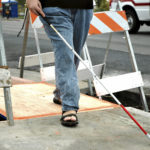
Orientation and mobility (O&M) specialists teach individuals with visual impairments to travel safely, confidently and independently in their environment. They work with infants, children and adults usually on a one-to-one basis in a home, school, hospital or in the community. Orientation and mobility specialists are different from physical therapists, because they focus on people with vision loss.
In a typical day, an orientation and mobility specialist might orient a college student who is blind to locate classes, the cafeteria and the library on a college campus; instruct a young adult who has low vision in the use of a GPS device; and teach a man who is visually impaired to cross two busy streets to get to the gym after work.
On another day, the specialist might orient a 30-year-old blinded veteran with a dog guide to her new job site; motivate an infant who is totally blind to engage in purposeful movement towards a musical toy; provide counseling to a high school junior who recently lost his vision and will not be able to get his driver’s license; and collaborate with city planners and traffic engineers to develop safe intersection designs for pedestrians who are visually impaired.
Does this sound interesting, rewarding, and different? There is a national shortage of mobility instructors. Jobs can be found worldwide.
If you are interested in working with people who have visual impairments, there are other careers in this category, including:
- Teacher of the Visually Impaired
- Vocational Rehabilitation Counselor
- Certified VISION Rehabilitation Therapist
- Certified Assistive Technology Instructional Specialist for People with Visual Impairments
Working Conditions
O&M specialists work in varied environments including homes, schools, rehabilitation centers, assisted living facilities, hospitals and rural and urban communities. They provide direct service to clients as well as consultative services to administrators, educational systems, medical personnel, government agencies, etc.
The work is challenging as clients deal with their disabilities in a variety of ways. The instructor needs to be flexible in scheduling and in teaching styles. Since every client is different, there is no “cookbook” approach to teaching mobility and nothing about it is routine.
Because of the demands of the job, mobility instructors tend to be in excellent physical shape. They work outdoors as well as indoors, under varying weather conditions. While it doesn’t take place in a classroom behind a desk, it is a teaching profession.
Salary Range and Outlook
Orientation and mobility specialists typically earn between $35,000 and $80,000.
Academic Requirements
The first orientation and mobility (O&M) specialists were trained by the military following World War II to help veterans blinded during the war. Training and certification has evolved since then.
Orientation and mobility programs offer bachelor’s and master’s degrees. Distance education classes are available. Coursework, a practicum and an internship are required. Some federal stipends for tuition are available. If you decide to major in orientation and mobility, ask the schools you are applying to about federal grants for tuition.
You can find a list of schools on the website of the Association for Education and Rehabilitation of the Blind and Visually Impaired.
Certification for orientation and mobility specialists and other vision professions is available through the Academy for Certification of Vision Rehabilitation and Education Professionals.
Resources
- Academy for Certification of Vision Rehabilitation & Education Professionals
- Association for Education and Rehabilitation of the Blind and Visually Impaired
